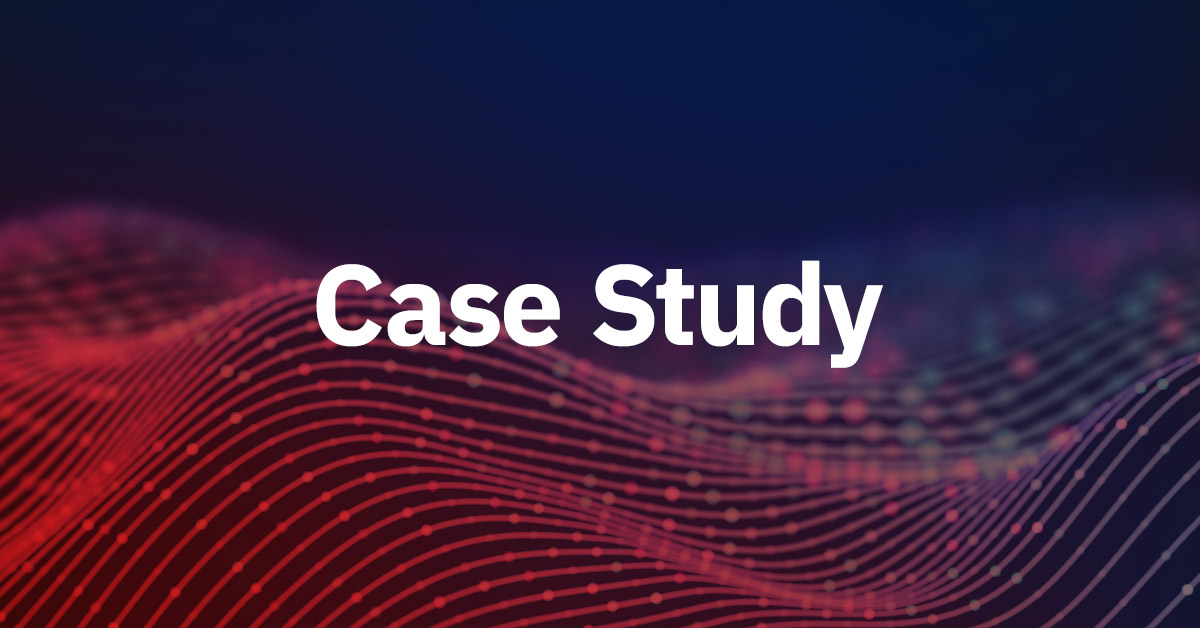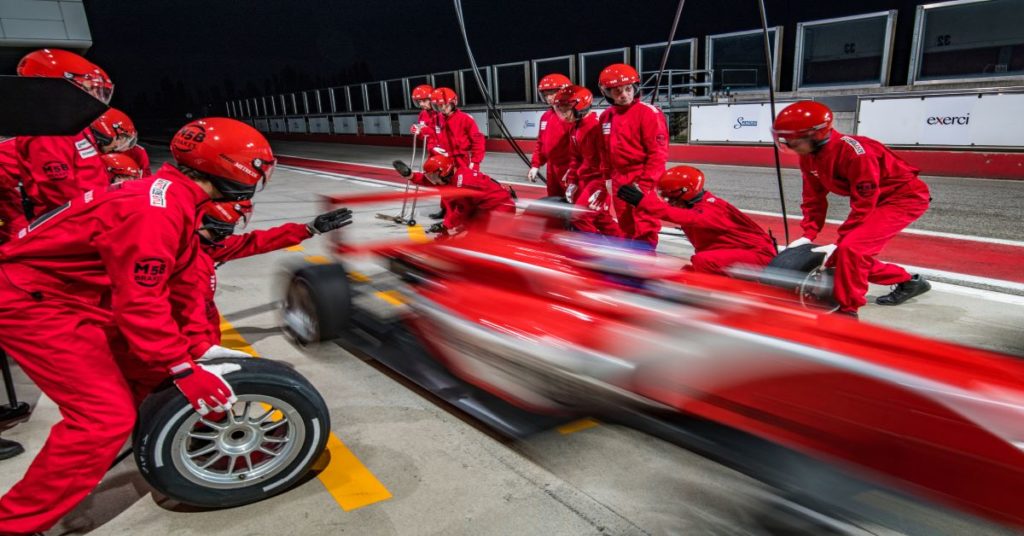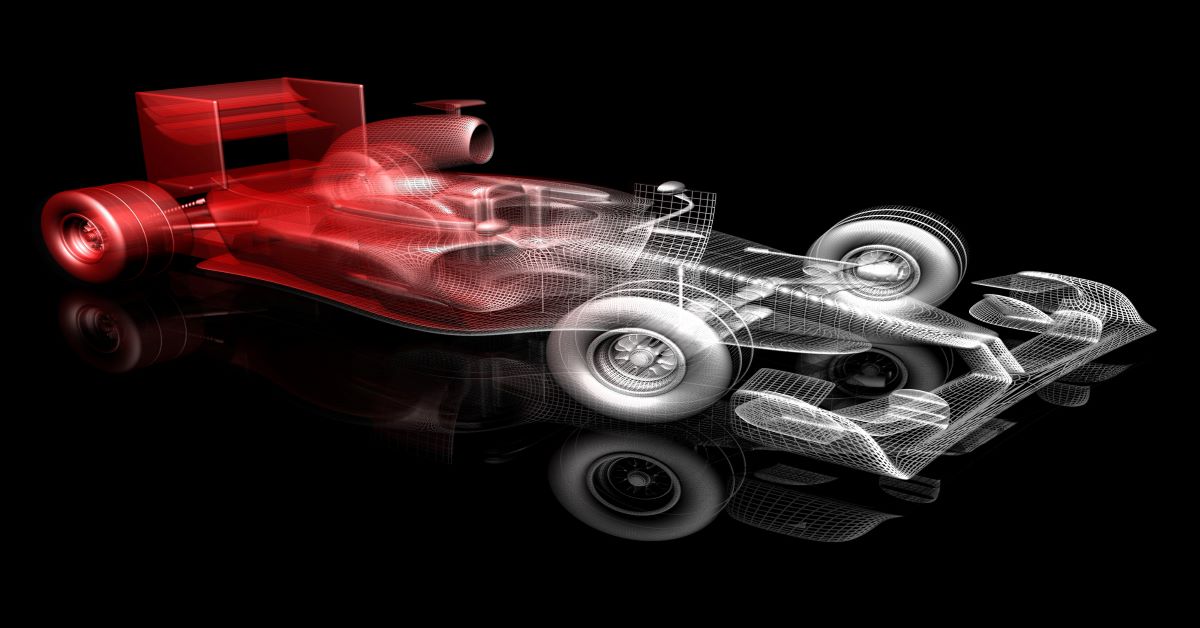

We are in a new age of competition that the World Economic Forum calls the 4th Industrial Revolution. New tools and technologies are enabling people to fulfill new and more competitive intentions ramping competitive pressures on everyone to move with speed and efficiency or risk failure. Incremental changes won’t work. They simply won’t be enough to be competitive. Step change improvements like those we’ve produced with our Accelerated Enterprise Asset Management Solutions execute our proprietary Time-to-Market Acceleration Algorithm.
- Speed Doubled – whether it’s doubling throughput in your asset-intensive operations, reducing calibration cycle time by 50% or getting assets you need.
- Costs Halved — at least. Accomplished by doubling, tripling or quadrupling asset utilization.
How? aEAM ends the need for users to hoard assets. It ends that One Bad Habit that Costs Your Teams Millions and that we’ve written about extensively on this blog!
Old Best Practices are Obsoleted by New Technology and Practices
Change is happening at an unprecedented rate. It is a time of great threat and a great opportunity where winners are easy to see and losers just fade away.
Today’s new tools change the game just like they did in previous industrial revolutions. The tools of the last industrial revolution enabled the division of labor and specialization. Operators and their machines performed standardized work sequenced in assembly lines. Alfred Sloan at GM used these principles to create the hierarchical business structures that are so common today using standardized work and division of labor between departments. GM became the most powerful business in the world in the most powerful industry in the world while crushing competition that couldn’t change fast enough. We must learn to exploit today’s new tools before our competition does. This must happen at every level of our companies. Individuals and departments must change both how they work and why they work if the companies they work for are to be successful. More than ever, employees must be focused on the value they produce that enables them to earn a living while forwarding department and enterprise goals for speed, innovation, and competitiveness. They must focus on new, more competitive intentions. May don’t know what’s possible. We can help.
A Thought Experiment
I’ve adapted this thought experiment from one Toby Hecht uses in his book, “Aji, An IR#4 Business Philosophy“, which I highly recommend for people and companies looking to double their productivity, value, and income.
Imagine you could time travel to prehistoric times with a rifle. If you gave it to a pre-historic hunter and told him it was a better tool for hunting, they’d likely try to use it like a spear or club if they used it at all. They wouldn’t understand the new space of possibilities the rifle opened for them to increase their output and speed while reducing the risk of injury during the hunt and giving them more time to accomplish other important objectives.
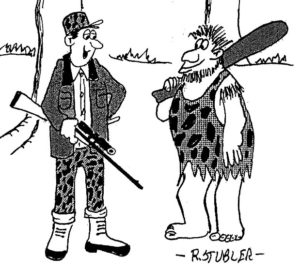
The metaphor works today. Today’s new tools are the metaphorical “rifle” which, unless understood, will be used in the same manner as the old tools with only small improvements. Without changing our intentions, mindsets, and practices, and with them our culture, we can not be successful. The changes that must be made are not easy and certainly not obvious but essential for business survival.
Lessons From the Military
In his best-selling book, “Team of Teams”, Stanley McChrystal describes the transformation he led of the Joint Special Operations Command. He claims we were losing the war in Iraq to an enemy exploiting technology –cell phones and social media – to go faster. His organization was rigid and slow and couldn’t respond quickly enough to the enemy. He knew they required new technology to compete but knew if they used it with their existing, deeply-ingrained cultural mindset, nothing would change. We’d continue to lose. He knew producing a culture of trust and empowerment was key but wouldn’t be easy given the distrust that had built over years that prevented getting everyone’s knowledge into the game. He succeeded and within three years McChrystal drove a culture that accelerated missions from 18/month to over 300 and from losing the war to winning. The distrustful hierarchy that McChrystal had to deal with in the military is very similar to the ones Sente’s been helping for over 20 years and that still exists today.
Sente’s Culture Change Algorithm: Trust –> Truth –> Collaboration & Innovation –> Speed –> Competitive Advantages & Successful Outcomes
It is clear trust is important. Skill at producing it, therefore, is equally important. Trust is built when people are open and sincere, have the skills required to produce the intended outcomes of their job, and are reliable. Trust enables people to anticipate how others will act with respect to what they care about. As trust builds people share the truth openly and the operating situation is revealed for everyone to see and work on together.
The truth we are after is not just the kind of truth that comes from straight talk and eliminating CYA. The deeper truths are based on the principles, laws, and mechanisms (engineering, economics, cognitive science, communications, strategy) from important historical discourses that enable people who know them to act effectively. You wouldn’t want a Communications major designing and testing a new satellite any more than you would want an engineer pulling someone’s tooth or designing and crafting critical communications without the skill to do so. Without the truth, we fail, and go crazy, literally. A good read for a deep, philosophical conversation on truth is contained in Princeton professor Harry Frankfort’s book, “On Truth“.
Intervening with Accountability Algorithms to Produce a Virtuous Cycle of Improvement
Sente’s integrated-systems and tools use our proprietary “Accountability Practices” to baseline and enable trust to build between departments. This is the launch point for our Culture Change Algorithm, as shown in the diagram below.
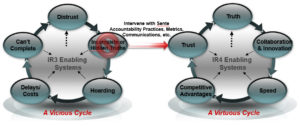
Building Cultural Momentum and Competitive Advantages
When people are open with each other and have the skills they need on the team to interpret new situations, describe them to each other and act together to cope with or exploit them they will move faster and be more effective. They won’t break trust through CYA or “multi-tasking”. The teams will be laser-focused on outcomes: capability, quality, cost, etc. They won’t be casual, they’ll be serious…which doesn’t mean they won’t have a lot of fun! An environment like this is a perfect environment to percolate new ideas and innovation and quickly from this comes the competitive advantages we all need to win.
Winning depends on the outcome we are after, and all previous steps in the algorithm are aimed at the outcome. You need to be trustworthy in areas that matter to the outcome, have knowledge that gives you access to truths relevant to the outcome and you have to be surrounded by others who are trustworthy and round out the set of skills required for the team to be successful.
Change happens one person at a time. It has to start with the leader, by definition, and the leader must have followers…also, by definition. The followers must produce results that gain the attention of others who will want to know how they are achieving their successes. Others join on board because everyone wants to be successful. Structures are put in place for learning from each other and collaborating. In these environments, the new moods of trust, passion, humility, and seriousness replace the old moods of distrust, resignation, not-invented-here, and casualness. The new moods become contagious because they open spaces for people to succeed to take care of their most fundamental concerns for career and family and because they produce wins and winning is fun.
Sente’s Approach: Begin the Change in Your Test Organization
Our test resource management software solutions as services are all designed to execute our culture change algorithm. We help organizations significantly invested in test — including equipment, facilities, and other resources — enable their customers in engineering and manufacturing to move with speed and competitiveness by accelerating time-to-market and revenue recognition. We do this by helping our customers who use our solutions produce a microcosm of the cultures enterprise executives are looking to produce — trust, collaboration, innovation, and speed — aligned with the goals and objectives of the enterprise. We ensure the microcosm culture is aligned with the company’s targeted culture and behaviors ensuring it becomes contagious and spreads. We call our approach, The Sente Way. With The Sente Way, we produce the groundbreaking results written about in our case studies. We engaged with customers in this way through our strategic services.
How Can You Design Software to Enable Culture Change?
Like we have with Accelerated Enterprise Asset Management! The software has to be multi-purposed and has to fit “hand-in-glove” with the practices required to baseline then modify cultural behaviors & practices and enabling the change to build momentum as discussed earlier.
Unlike the previous industrial revolution where tools were single purpose, computers and software can be multipurpose, if you know to design them that way. Mostly what we’ve seen is software still designed to be single-purpose and, as a result, reinforces the ineffective and slow “silo” culture. Tools fit four fundamental categories: production, coordination, communication, and learning. Each one of these categories of tool is critical to changing a culture and having software support your change enables it to happen at scale.
Feel free to look around our website and to check out our software and services.
Request a Demo
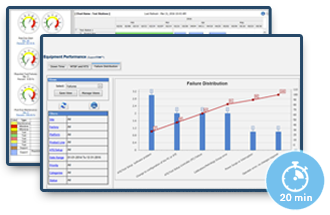
See how Scireo aEAM Software drops asset and support costs by 50% while accelerating time-to-market 2X.
Relevant Content
Case Study: Aerospace Company Drives One Company Synergies
Like many aerospace companies, this one had many sites and different legacy cultures on each. See how they installed common resource management tools, increased utilization 3X and funded new programs.
Case Study: Semiconductor Company Increases Test Equipment Utilization
This company had a leading market share and wanted to solidify its position with its strategic customers by installing test capabilities on their sites. See how a 40% increase in bench utilization funded the project.
Win the Race with Better Coordination of Capacity & Constraints
In today’s fast-changing environment, business teams need to be able to anticipate resource constraints and plan contingencies quickly to avoid costly delays and frustrations. Failure to perform to new competitive requirements could mean the difference between winning and losing new business. Teams are being asked to… Cut time-to-market by 50%… and cut cost 50%. Hoarding…
Asset Management 5.0: Designed for Speed & Competitiveness
Accelerated Enterprise Asset Management (aEAM) is an award-winning software and services suite used by companies with complex, asset-intensive operations and demanding competitive requirements for better than incremental improvements to speed, agility, and cost-effectiveness. The same old solutions won’t work. This is where Scireo aEAM comes in oto help transform your business. The Results with Asset…
Notable Quotes
“People often talk about change – Sente has demonstrated accomplishments in really producing lasting cultural change in our organization. The ROI (200%+) we produced with The Sente Group led to our team being recognized by the company with an enterprise-level best practice award. Over time the program went on to produce a 4X improvement to utilization and continued ongoing capital and expense savings.”
Business Unit Executive, Aerospace & Defense






